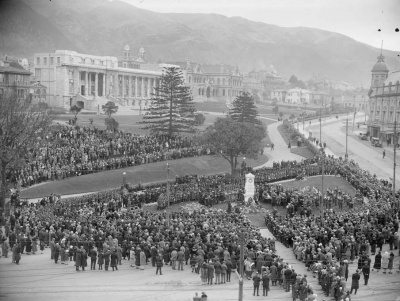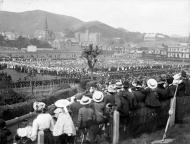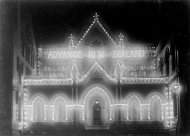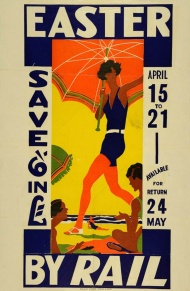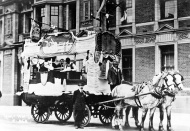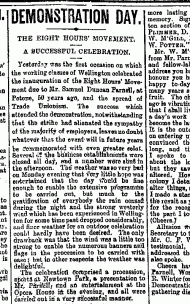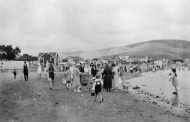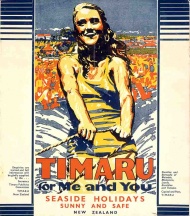Events In History
-
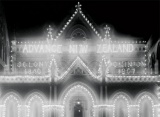 26 September 1907Joseph Ward proclaims dominion status
26 September 1907Joseph Ward proclaims dominion statusPrime Minister Ward read the proclamation to a smallish crowd from the steps of the General Assembly Library in Wellington. This first Dominion Day was a public holiday. Read more...
Articles
Empire Day

Empire Day (24 May), celebrated widely in New Zealand from 1903, was a major event in the viceregal calendar.
- Page 1 - Empire DayEmpire Day (24 May), celebrated widely in New Zealand from 1903, was a major event in the viceregal
Waitangi Day
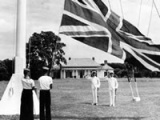
Every year on 6 February, New Zealand marks the signing of the Treaty of Waitangi in 1840. For most people, Waitangi Day is a holiday; for many, and especially for Māori, it is a time for reflecting on the Treaty and its place in modern New Zealand.
-
Page 4 – Waitangi Day 1960s
The Waitangi Day Act 1960 declared 6 February to be Waitangi Day; a national day of thanksgiving in commemoration of the signing of the Treaty of Waitangi.
-
Page 5 – Waitangi Day 1970s
Waitangi Day, a public holiday from 1974, briefly became New Zealand Day in the 1970s. Increasingly, it became a focus for Māori protest activities.
-
Page 6 – Waitangi Day 1980s
The 1980s brought changes in the way Waitangi Day was marked officially, as well as growing Māori protest.
-
Page 7 – Waitangi Day 1990s
In the 1990s Waitangi Day events became a focus for protests about sovereignty.
-
Page 8 – Waitangi Day in the 21st century
Waitangi Day in the 21st century has been linked more closely with New Zealand identity, and events have expanded beyond Waitangi itself. Protests have continued, and
Anzac Day
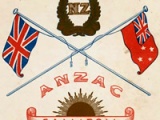
First observed in 1916, Anzac Day - 25 April - commemorates those killed in war and honours returned servicemen and women. The ceremonies held at war memorials around the country, and in places overseas where New Zealanders gather, are rich in tradition and ritual.
-
Page 2 – The Anzacs
The word Anzac is part of the culture of New Zealanders and Australians. The word conjures up a shared heritage of two nations, but it also has a specific meaning, dating from
-
Page 3 – The ceremony
The Anzac Day ceremony of 25 April is a form of military funeral and follows a specific pattern. The day's ceremonies have two major parts: one at dawn and another later in the
-
Page 4 – The making of Anzac Day
Anzac Day was made a half-day holiday in 1916, when the pattern of the day's events began to be set.
-
Page 5 – A sacred holiday
Anzac Day became a public holiday and took on new meaning in peacetime. It became a time to express sorrow, not glorify war, on a sacred day that had a secular tone.
-
Page 6 – Another war and peace
Anzac Day came to have a wider focus and the commemorations became more popular in the years after the Second World War.
-
Page 7 – Modern Anzac Day
Each generation of New Zealanders redefines Anzac Day to suit the mood of the times, and the last 50 years has seen much redefinition.
-
Page 9 – The red poppy
The red poppy has become a symbol of war remembrance the world over. In many countries it is worn on Armistice Day (11 November), but in New Zealand it is most commonly seen on
-
Page 10 – Further information
Links and books relating to Anzac Day
Dominion status

On 26 September 1907 the colony of New Zealand ceased to exist. It became, instead, a dominion within the British Empire.
-
Page 3 – The first Dominion Day
The first Dominion Day, 1907, was a holiday for public servants as all government offices closed to mark the occasion.
-
Page 4 – Demise of Dominion Day
Dominion Day, 26 September, never really took hold in New Zealand. Wellington was one of the few places that kept up ceremonies after 1907.
Labour Day
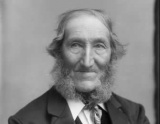
Celebrated on the fourth Monday in October, Labour Day commemorates the struggle for an eight-hour working day, a right that carpenter Samuel Parnell had famously fought for in 1840. Our first Labour Day was held on 28 October 1890, and it has been a statutory public holiday since 1900.
- Page 1 - Labour DayCelebrated on the fourth Monday in October, Labour Day commemorates the struggle for an eight-hour working day, a right that carpenter Samuel Parnell had famously fought for in
Christmas in New Zealand

Christmas in New Zealand is less about snow and sleigh bells and more about sun, sand and backyard barbecues. Over the holiday season we explore the Kiwi Christmas experience –
from Abel Tasman’s first New Zealand Christmas in 1642 to the declining
reign of the Queen’s message- Page 1 - Kiwi ChristmasChristmas in New Zealand is less about snow and sleigh bells and more about sun, sand and backyard barbecues. Over the holiday season we explore the Kiwi Christmas experience –
Anzac Day in the Pacific
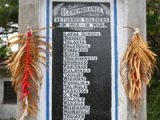
Armistice Day was the initial focal point for commemorations in the Cook Islands and Niue after the First World War. But because men from both countries had served in the New Zealand Expeditionary Force, observances gradually shifted to Anzac Day in April
-
Page 2 – Early commemorative efforts
During the 1920s war memorials provided a focus for commemoration services in the Cook Islands, where the first Anzac Day service was possibly held in 1927. On Niue, Armistice
-
Page 3 – The growth of Anzac Day
By the end of the Second World War military commemorations in the Cook Islands and Niue centered around Anzac Day. Services in both countries followed the pattern of those in
Related keywords
- WW1
- anzac day
- cook islands
- niue
- pacific peoples
- dawn service
- war memorials
- RSA
- cemeteries
- joseph ward
- parliament
- dominion day
- dominion of new zealand
- anniversaries
- william massey
- poetry
- public service
- parliament buildings
- wellington city
- wellington cenotaph
- children
- empire day
- whanganui city
- health
- basin reserve
- libraries
- tourism
- railways
- poster
- protest
- waitangi day
- race relations
- hikoi
- 1980s
- sesquicentenary
- treaty claims
- christmas
- economy
- labour day
- parades
- samuel parnell
- newspapers
- plimmerton
- radio broadcasts
- gallipoli campaign
- holidays
- timaru
- caroline bay
- queen elizabeth
- 1960s
- WW2
- religion
- helen clark
- governor-general
- flags
- charles bledisloe
- norman kirk
- new zealand day
- matiu rata
- waitangi tribunal
- national identity
- 1970s
- anzac
- death
- red poppy
- christianity
- food
- australia
- workers rights
- liberal party
- trade unions
- treaty of waitangi
- memorials
-
Anzac Day ceremony at the temporary Cenotaph, outside Parliament House, 1927

